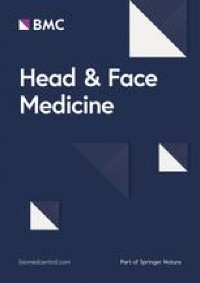|
Medicine by Alexandros G. Sfakianakis,Anapafseos 5 Agios Nikolaos 72100 Crete Greece,00302841026182,00306932607174,alsfakia@gmail.com,
Αρχειοθήκη ιστολογίου
-
►
2023
(272)
- ► Φεβρουαρίου (141)
- ► Ιανουαρίου (131)
-
►
2022
(2066)
- ► Δεκεμβρίου (80)
- ► Σεπτεμβρίου (170)
- ► Φεβρουαρίου (190)
- ► Ιανουαρίου (203)
-
▼
2021
(7399)
- ► Δεκεμβρίου (186)
- ► Σεπτεμβρίου (472)
-
▼
Μαρτίου
(745)
-
▼
Μαρ 29
(60)
- How Face Masks Affect Acoustic and Auditory Percep...
- A novel seven‑gene panel predicts prognosis of hea...
- Bilateral Chronic Subdural Hematomas
- Endonasale konfokale Laserendomikroskopie – erste ...
- Management of Lingual Thyroid with Second Thyroid ...
- Application of auriculotemporal nerve block and de...
- Tympanic membrane perforations: a critical analysi...
- The protective effect of Naringenin against ovalbu...
- Lacrimal sac diverticulum: clinical presentation a...
- Challenging the gold standard: methods of sampling...
- Patterns of cervical lymph node metastasis in supr...
- Audiological practice and COVID-19: recommendation...
- How face masks influence the sinonasal quality of ...
- Comparison of postoperative morbidity between piez...
- Stimulated whole salivary flow rate: The most appr...
- Evaluation of the xerostomia, taste and smell impa...
- Non-specific oral and cutaneous manifestations of ...
- Oral mucositis. Is it present in the immunotherapy...
- Cranial fat dissemination following fat grafting f...
- Lacrimal Sac Anterior Border-Maxillary Line Distan...
- Community-acquired Haemophilus influenzae meningit...
- Long-term follow-up of olfactory and gustatory dys...
- Lumboperitoneal shunts for the treatment of idiopa...
- Pain management in cancer patients in a Tunisian h...
- Pioneering Iodine-125-Labeled Nanoscale Covalent O...
- Emerging and distinct video head impulse test resp...
- Primary epidural lumbar Ewing sarcoma presenting a...
- The effect of platelet-rich fibrin (PRF) on wound ...
- Endoscopic Cartilage Umberlla Ossiculoplasty: As T...
- Patient‐specific Virtual Temporal Bone Simulation ...
- Do Perioperative Systemic Corticosteroids Improve ...
- Improved Patient Dosimetry at Radioiodine Therapy ...
- Therapeutic Plasma Exchange in Refractory Hyperthy...
- Quality of Life during Treatment with Lenvatinib f...
- microRNA-23 inhibits inflammation to alleviate rhe...
- Distinctive gut microbial dysbiosis between chroni...
- Protein tyrosine phosphatase receptor-type O expre...
- Recent advances of glucocorticoids in the treatmen...
- Clinical application of liver stiffness measuremen...
- Congenital dyserythropoietic anemia and drug-induc...
- miR-23a-3p regulates the proliferation and apoptos...
- Dysregulation of lncRNA SNHG1/miR-145 axis affects...
- The Endonasal Endoscopic Management of Cerebrospin...
- Compartmentalization: An Open Technique for Fronta...
- Reconstruct the anterior commissure with intralary...
- The Prognostic Variables Affecting the Frontal Sin...
- Intraoperative botulinum toxin injection for super...
- Primary Transoral Robotic Surgery +/‐ Adjuvant The...
- Nasopharyngeal Carcinoma in Dermatomyositis
- Role of PD‐1/PD‐L1 inhibitors in the treatment of ...
- Instant Auditory Benefit of an Adhesive BCHD on Ch...
- Ectopic maxillary sinus third molar with dentigero...
- Using the PRAAT software to describe dependence of...
- Stapler closure versus manual closure in total lar...
- Automated assessment of cortical mastoidectomy per...
- The impact of frailty on epistaxis admission, a re...
- A systematic review of outcomes of remote consulta...
- Patient perspectives on recall period and response...
- Referral pattern of oral and maxillofacial surgery...
- Preventing cerebral spinal fluid leakage following...
-
▼
Μαρ 29
(60)
- ► Φεβρουαρίου (851)
-
►
2020
(2517)
- ► Δεκεμβρίου (792)
- ► Σεπτεμβρίου (21)
- ► Φεβρουαρίου (28)
-
►
2019
(12076)
- ► Δεκεμβρίου (19)
- ► Σεπτεμβρίου (54)
- ► Φεβρουαρίου (4765)
- ► Ιανουαρίου (5155)
-
►
2018
(3144)
- ► Δεκεμβρίου (3144)
Ετικέτες
Πληροφορίες
Δευτέρα 29 Μαρτίου 2021
How Face Masks Affect Acoustic and Auditory Perceptual Characteristics of the Singing Voice
A novel seven‑gene panel predicts prognosis of head and neck squamous cell carcinoma treated with platinum‑based radio(chemo)therapy
|
Bilateral Chronic Subdural Hematomas
|
Endonasale konfokale Laserendomikroskopie – erste Anwendung und Validierung von Malignitätskriterien
|
Management of Lingual Thyroid with Second Thyroid Anomaly: An Institutional Experience
|
Application of auriculotemporal nerve block and dextrose prolotherapy in exercise therapy of TMJ closed lock in adolescents and young adults
|
Tympanic membrane perforations: a critical analysis of 1003 ears and proposal of a new classification based on pathogenesis
|
The protective effect of Naringenin against ovalbumin-induced allergic rhinitis in rats
|
Lacrimal sac diverticulum: clinical presentation and endoscopic management
|
Challenging the gold standard: methods of sampling for microbial culture in patients with chronic rhinosinusitis
|
Patterns of cervical lymph node metastasis in supraglottic laryngeal cancer and therapeutic implications of surgical staging of the neck
|
Αναζήτηση αυτού του ιστολογίου
! # Ola via Alexandros G.Sfakianakis on Inoreader
-
Does CBD Oil Lower Blood Pressure? This article was originally published at SundayScaries." Madeline Taylor POSTED ON January 13, 20...
-
The device, cleared in Europe a couple of years ago, is used to ablate cardiac tissue as part of treatment for atrial fibrillation. It featu...
-
Overdue: a US advisory board for research integrity Overdue: a US advisory board for research integrity, Published online: 11 February 201...



